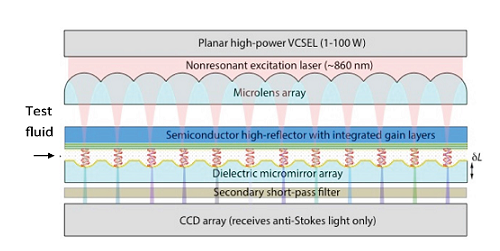Competitive Advantages
- Ultra-high sensitivity and specificity
- Low-cost, durable and compact structure
- GHz range spectral resolution without requiring spatial beam propagation, frequency stabilization, or spectroscopic equipment
Summary
USF inventors have developed an accurate integrated chemical sensing platform to meet this long-standing, yet unfulfilled need. Resonant micro-cavity technology is used to significantly enhance chosen chemical fingerprint signals (coherent anti-Stokes Raman scattering (CARS)) from an ensemble of trace chemicals in a fluid. The detection techniques are also extended from single–gas sensor to dual–gas sensor based on an enhanced spontaneous dual emission as a result of cavity quantum electrodynamic effects. This ultra-high sensitive chemical sensor can be used in chemical, pharmaceutical, defense, food, and beverage industries for quality control purposes. Its compactness allows integration into portable electronic devices such as cell phones and durability makes it suitable for space missions where chemical sensors are in a great need for biomedical experimentation, the monitoring of water, and air recycling processes.

Cross-Sectional View of Developed Detection Array
Desired Partnerships
- License
- Sponsored Research
- Co-Development